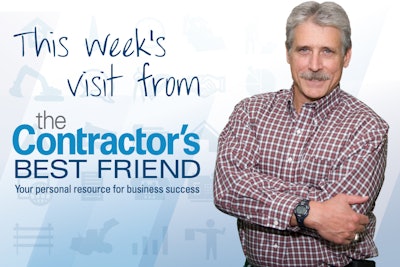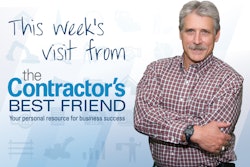
I’ve written about risk management several times since I started this newsletter and last week I decided to report a conversation I had with Jeff Copeland, risk management expert and consultant. I asked Jeff to list the 10 areas all contractors could benefit from addressing in risk management and here’s the list he provided:
- Safety - Be proactive! Bad Workers Comp ratings or OSHA fines can put you out of business.
- Collect your receivables. Know the billing cycles and don’t be late. Being a couple of days late with your bill can delay your payments an additional 30 days.
- Know the language of your contract as well as the GC’s contract with the Owner.
- Understand the difference between “Pay if paid” vs. “Pay when paid.” The interpretation can vary state to state so talk to your lawyer if you have any doubts or questions.
- Retainage requirements. If you are one of the early subcontractors on the project, push for early partial release.
- Levels of authority
- Change notice requirements
- Bid work within your competency. Don’t “experiment” bidding work you don’t have the experience to perform.
- Participate in the development of the “for construction” schedule. Don’t let someone else tell you how to manage your company.
- Don’t wait until your work is done to start “As-Builts” and “operations & maintenance” manuals. It will slow down when you will get paid.
- Train your field leaders. Labor is usually your most expensive cost and the cost that can turn a good job into a loser.
- Keep learning. Join your trade association and take advantage of their training programs. Push for more education on risk management for contractors in your same field or size of company.
- Make sure the Site Access Plan does not cause you to handle your materials multiple times.
- Make sure your field people know the drawings and fight for the Change Order’s you deserve.
My comment to Jeff was, “That’s a pretty exhaustive list,” but we jumped right in and tackled the first five topics last week. This week we’ll work on the rest… so let’s see how we can help you manage risk in your business!
Brad: Jeff, your tip number six refers to “As-Builts” and “operations & maintenance” manuals. I’m not sure that this applies to all of our Contractor’s Best Friend readers. Is there still something for the specialty contractor to take away?
Jeff: While the specialty contractor may not be required to complete “As-Builts” or “O&Ms” for work completed, the lesson here is to educate customers on what things were completed, how they were completed, and recommend maintenance efforts for long-term satisfaction. This is a great opportunity to market your company and future services. Also, such an effort can prevent any customer from coming back in a threatening way and raising questions in anger about information that could have been provided easily.
Brad: OK, then for the small contractor, could a simple description of what a customer can do to maintain the recently completed work suffice? For example, maybe the flat work concrete company who put in a new parking lot for a strip mall might provide some documentation that would educate the customer on how to best maintain the lot to get the maximum life?
Jeff: I would think that would be a great step in the right direction to manage any future risk, not to mention providing greater service to your customer.
Brad: OK, Jeff, your seventh and eighth tips are interesting, as I’ve addressed these educational tips in previous articles. Without repeating some of the insights I have already provided our readers, can you expand on training and learning?
Jeff: Education is simply the only way we’re really going to win the risk management game. The contractor who consistently educates his or her employees to performing work smarter and safer will “win” in the end. Fines and discipline are needed, of course, for contractors who are trying to cut their costs and essentially making the playing field uneven. But at the heart of any real success, both in safety and in maintaining a profitable business, education is the first place I would start.
Without being too obviously promotional for what you do, Brad, I would highly recommend that contractors bring in outside consultants like you (and me) to educate their leaders and workers on risk management efforts. Now, a great source of this education can be found easily in the many contractor associations that are now prevalent. There just isn’t any excuse anymore about getting all the information you can to build a better, growing, safer and more profitable company.
And one more point that I think is important. I know earlier I made reference to OSHA fines. Look, because so much information and so many resources are available today for contractors, most local, state and federal agencies do not have the patience or tolerance that they once had. So, if you desire to grow your construction business you had better take another serious look at the entire risk management arena.
Brad: Thanks, Jeff. Let’s look at your last two tips. I think they are both great as they relate to risk management. The ninth tip really supports the “looking for stuff” reality that many contractors contend with from their workers.
Jeff: Yes, I’ve heard you address this growing problem before and as it relates to multiple handling and transporting on a job site, there’s not a more costly “disease” for contractors to address. Again, thinking of the smaller contractor who completes several jobs in a day or week, the need for a site plan may be more critical than even for the larger contractor who might be on a job site for days or weeks at a time.
Let me simply say, no matter who you perform work for, be sure to have a clear understanding of how your crews and suppliers are to access the work site. I have always recommended documenting this effort, too, as it is amazing how quickly a customer, including the GC (and I was one!), can forget to what he had agreed to in an earlier conversation.
Brad: Jeff, your tenth and final tip addresses Change Orders. I have written about this great need on earlier occasions but COs is still a topic that just doesn’t permeate enough of the specialty construction market. Can you address this very important item?
Jeff: In a word, Change Orders represent money! We hear a lot about contractors bidding work at lower profits than ever but what we don’t always hear enough about is that customers are changing their minds more than ever. A brief example is worth the time here.
Let’s say a property manager of condominiums contracts with a specialty contractor, let’s say a full service pavement maintenance contractor. Under the contract, the contractor is to pave, put in curb and gutters, stripe, seal and replace all of the trash dumpster pads. I mean, he’s got the entire enchilada of work to perform. Now, the contractor had to bid the work very cheap to get the job and the property manager was very cautious about how much he was allowed to spend.
Now, after the contractor starts working the owner of the condos stops by to see how the work is going. He sees a few additional areas needing work and inform his manager to talk to the contractor about doing additional work. When the manager approaches the contractor about the changes the contractor, not wanting to disappoint the manager and raise uncomfortable questions to ask the owner, quickly agrees to the changes. The contractor figures he might make some minor adjustments on his end but realizes that he may be giving away a few thousand dollars of profit to comply with the request.
What should happen here is that the contractor should very clearly state that he will be more than happy to complete the additional changes BUT only after a formal Change Order is completed. You are talking about managing a huge risk of profitability! I’ve heard hundreds of stories about contractors who either made a lot less profit or actually lost money because they performed additional work, outside the contractual directions.
Brad: Thanks Jeff! Great example and a great reminder of how critical it is that any change to the original contract be clearly specified -- along with a specific price for the additional services -- and signed before completing any work. We need to stop giving away work, which is really giving away profit!
As you can tell from our interview, risk management is really about more than just “safety.” For the general contractor, project manager or superintendent at a larger contractor, many of the issues addressed by Jeff Copeland the last two weeks are not new. The issues may or may not be effectively addressed in their company, but they most likely have experienced some or all of these issues before.
However for the contractor reading this article who is recognizing these risks for the first time, don’t leave your reading with anything less than a commitment to make sure you are cleaning up the risk that your company might be experiencing. Risk management really is HUGE!
Good luck in addressing your own risk management issues. For more help in this area don’t be shy about contacting me -- or if you would like to secure the services of Jeff Copeland just let me know and I’ll be happy to connect you up.
If I may, let me invite you to provide some feedback to The Contractor’s Best Friend™ blog. Please address the following question:
What risk management tip do you struggle with the most? What questions do you have that we might address either on the blog or in a future article?
Here’s to a less risky effort in managing your company!
Brad Humphrey
© 2013 Brad Humphrey, Pinnacle Development Group/The Contractor’s Best Friend™
For more information on risk management or about Jeff Copeland, please send your request to The Contractor’s Best Friend™ blog or email [email protected].



















